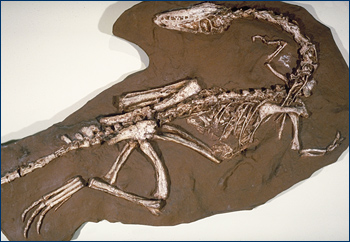
Coelophysoidea
Coelophysoids lived during the Late Triassic to Early Jurassic and had an almost global distribution. They were relatively small, bipedal carnivorous dinosaurs.
Fossils of Coelophysis bauri, one of the earliest known theropods, have been found in huge assemblages in New Mexico, hinting that some theropods may have been gregarious. An example of a beautiful specimen of Coelophysis is shown below. UCMP has a fine specimen from the Petrified Forest of Arizona, a paleontologist's paradise.

|
Segisaurus halli, a unique coelophysoid housed in the UCMP collections, was a small (about three feet long) theropod described by UCMP paleontologist Charles L. Camp in the 1930s. Found in the Navajo sandstone of Arizona, Segisaurus perplexed paleontologists for many years. First, though the specimen was nicely preserved, it lacked a skull — this made it difficult to establish its relationship to other theropods. Furthermore, its bones appeared to be solid unlike typical theropods, and finally, Camp found what seemed to him to be evidence of clavicles, which were unknown in dinosaurs at the time. A new study of the Camp specimen was undertaken by Matt Carrano et al. in 2005. They found that the bones were indeed hollow and that what Camp thought was a clavicle was actually a furcula (wishbone), a feature often found in basal theropods. The study determined that Segisaurus was clearly a coelophysoid. Besides Segisaurus, another relative of Coelophysis is Syntarsus, a dinosaur known from excellent remains found in South Africa and Arizona.
|
Source:
|
Portions of this page created by John Hutchinson 11/1995; modifications and additions since 2005 by David Smith.